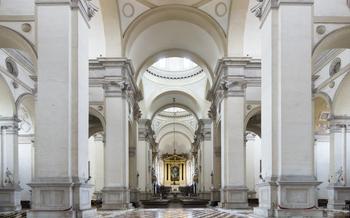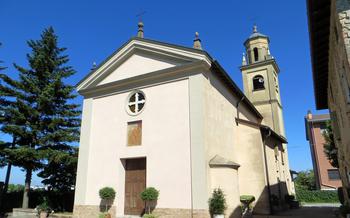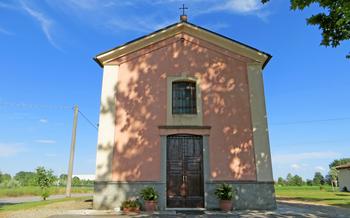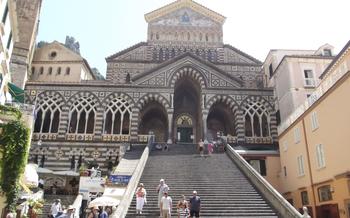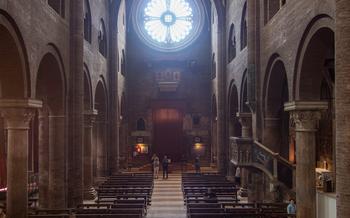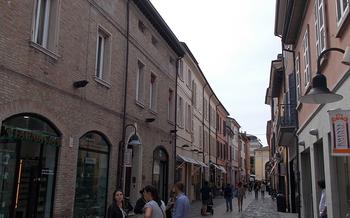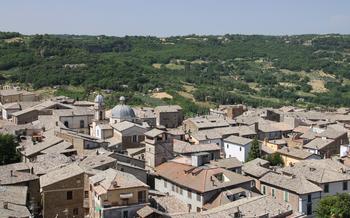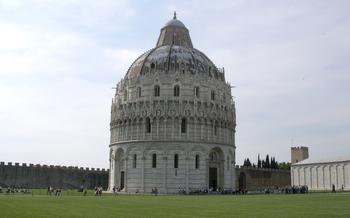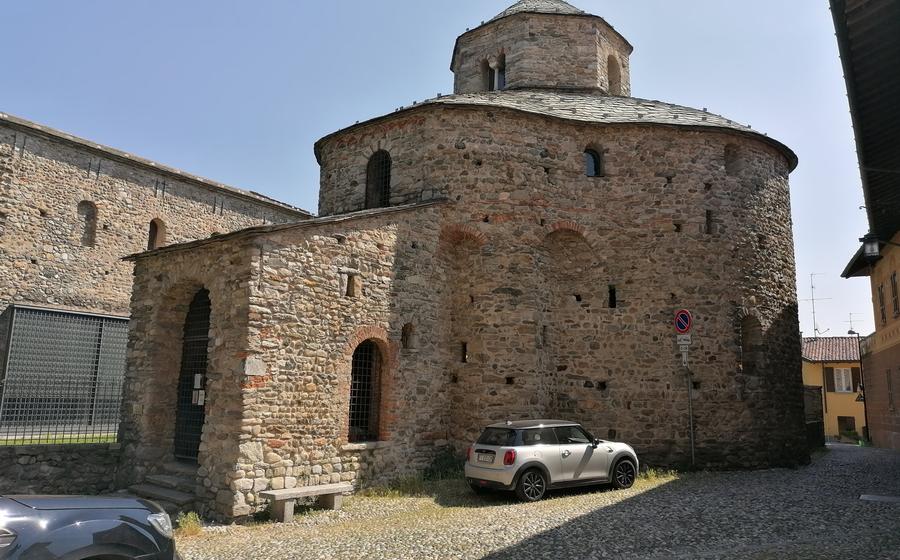
Baptistery of Parma (Battistero di Parma)
- Introduction
- Architectural Style and Significance
- Location and How to Get There
- History of the Baptistery of Parma
- Architectural Highlights
- The Exterior
- The Interior
- The Baptistery's Symbolism
- The Baptistery's Role in Parma's History
- The Sculptures of Antelami
- The Frescoes in the Dome
- The Colors and Patterns
- The Baptistery as a UNESCO World Heritage Site
- Myths and Legends Surrounding the Baptistery
- The Baptistery's Impact on Art and Architecture
- Tips for Visiting the Baptistery of Parma
- Insider Tip: Unveiling Hidden Symbolism
Introduction
Located in the heart of Parma, Italy, the Baptistery of Parma (Battistero di Parma) stands as a testament to the city's rich history and architectural heritage. This iconic monument, constructed in the 12th century, is renowned for its stunning octagonal shape, breathtaking frescoes, and intricate sculptures that blend Romanesque and Gothic elements. Join us as we explore the wonders of the Baptistery of Parma, a masterpiece of medieval art and architecture that captivates visitors with its unique charm and profound symbolism.
Architectural Style and Significance
The Baptistery of Parma is a remarkable example of Romanesque architecture, showcasing a harmonious fusion of Romanesque and Gothic elements. Its octagonal shape, a unique feature at the time of its construction, symbolizes the eight days of Creation and the perfection of the divine. The exterior of the building is adorned with elegant blind arcades and pilasters, creating a rhythmic and visually appealing facade. The interior features stunning frescoes by Benedetto Antelami, portraying biblical scenes with intricate details and vibrant colors. These artistic masterpieces, along with the harmonious blend of architectural styles, contribute to the Baptistery's exceptional significance as a testament to the artistic and cultural achievements of the Middle Ages.
Location and How to Get There
The Baptistery of Parma is conveniently located in Piazza del Duomo, the central square of Parma. Visitors can easily reach the Baptistery on foot from any part of the historic center. The city of Parma is well-connected by public transportation, with regular bus and train services from major cities in Italy. Once in Parma, the Baptistery is within walking distance from the main train station, making it easily accessible for both domestic and international travelers.
History of the Baptistery of Parma
The construction of the Baptistery of Parma, a true masterpiece of Romanesque architecture, commenced in 1196 under the patronage of Bishop Guido, a man of great vision and ambition. Guided by his unwavering faith and desire to leave an indelible mark on the city, Bishop Guido commissioned the construction of this magnificent edifice. The project was entrusted to the skilled hands of Benedictine monks, who brought their expertise and devotion to the task. The influence of both the Lombard and Byzantine architectural styles is evident in the Baptistery's design, reflecting the diverse cultural influences that shaped Parma during that era.
The Benedictine monks, renowned for their architectural prowess, played a pivotal role in the construction of the Baptistery. Their expertise in masonry and their dedication to precision and detail are evident in the Baptistery's harmonious proportions and intricate carvings. Drawing inspiration from the Lombard and Byzantine styles, the monks created a unique architectural masterpiece that would become a symbol of Parma's religious and civic power. The Lombard influence is particularly visible in the Baptistery's octagonal shape and the use of blind arcades, while the Byzantine influence is evident in the intricate mosaics and the rich ornamentation that adorns the interior.
Guided by their faith and artistic vision, the Benedictine monks meticulously crafted every element of the Baptistery, ensuring that it would stand as a testament to their skill and devotion. Their dedication and hard work resulted in the creation of a sacred space that would inspire awe and reverence for generations to come.
Architectural Highlights
The Baptistery of Parma boasts a unique octagonal shape, a departure from the traditional circular form of most baptisteries. This distinctive design holds symbolic significance, representing the eight days of the week and the resurrection of Christ on the eighth day. The elegant blind arcades and pilasters, which decorate the exterior, add to its architectural charm. The harmonious blend of Romanesque and Gothic elements further enhances the Baptistery's visual appeal. Perhaps the most striking feature is the magnificent dome, which crowns the structure. Its intricate design and intricate mosaics, depicting biblical scenes and celestial beings, are a testament to the skill and artistry of the medieval craftsmen who created this masterpiece.
The Exterior
The facade of the Baptistery of Parma is a masterpiece of Romanesque sculpture, adorned with intricate carvings and bas-reliefs that depict biblical scenes and figures. The lower section features a series of blind arcades, each housing a sculpted figure of a prophet or saint. Above these arcades, a frieze runs around the entire circumference of the building, depicting scenes from the Old and New Testaments. The frieze is a remarkable example of medieval storytelling, with each scene rendered in intricate detail, capturing the emotions and drama of the biblical narratives.
The entrance to the Baptistery is flanked by two majestic lions, symbols of strength and protection. These lions are believed to represent the guardians of the sacred space within, ensuring its sanctity and warding off evil spirits.
The harmonious interplay of light and shadow on the Baptistery's exterior adds to its dramatic effect. The intricate carvings and sculptures cast long shadows as the sun moves throughout the day, creating a dynamic and ever-changing spectacle. This interplay of light and shadow further enhances the Baptistery's visual appeal, making it a truly mesmerizing sight to behold.
The Interior
The interior of the Baptistery of Parma is a breathtaking spectacle, immersing visitors in an atmosphere of awe and wonder. Rich ornamentation adorns every surface, creating a harmonious blend of colors, patterns, and intricate details. Highlights include the stunning frescoes by the renowned sculptor and artist Benedetto Antelami, which grace the walls and dome and depict biblical scenes with remarkable realism and emotional depth. The frescoes are a testament to Antelami's mastery of the human form and his ability to convey religious narratives with power and conviction.
The depiction of biblical scenes in the Baptistery's interior holds deep theological significance. Antelami's works celebrate the life and teachings of Christ, emphasizing the importance of faith, redemption, and the triumph of good over evil. The frescoes serve as a visual guide for the faithful, offering a deeper understanding of the Christian faith and its central tenets. The interplay of colors and patterns adds to the immersive experience, creating a vibrant and dynamic فضای داخلی. The harmonious blend of hues and motifs creates a unified effect, drawing the viewer's eye to the intricate details and symbolism embedded within the artwork.
The Baptistery of Parma's interior is a masterpiece of medieval art and architecture, showcasing the skill and artistry of Benedetto Antelami. The frescoes, with their emotional depth and theological significance, invite visitors to contemplate the mysteries of faith and the power of artistic expression.
The Baptistery's Symbolism
The Baptistery of Parma holds profound symbolic meanings that transcend its architectural beauty. It stands as a testament to the city's religious and civic power, embodying the essence of Christianity and its rituals. Water, a central element in Christian tradition, plays a significant role in the Baptistery's symbolism. Baptism, the sacrament of initiation into the Christian faith, is performed within its sacred walls, representing the purification and rebirth of the soul.
The Baptistery's elaborate decorations further enhance its symbolic significance. The virtues and vices depicted in the sculptures and frescoes serve as moral guides, reminding believers of the path to righteousness. The integration of pagan and Christian iconography reflects the blending of ancient traditions with the new faith, creating a unique and cohesive visual narrative.
The Baptistery's Role in Parma's History
Throughout its existence, the Baptistery of Parma has played a pivotal role in the city's history, serving as a sacred space for baptisms and religious ceremonies. Its significance extends beyond its religious function, as it has been the site of important civic events and celebrations, reflecting the deep connection between the Baptistery and the community of Parma. The enduring presence of the Baptistery amidst historical changes and conflicts speaks to its resilience and adaptability, embodying the spirit of Parma's perseverance. As a symbol of the city's heritage, the Baptistery continues to inspire awe and reverence among locals and visitors alike, standing as a testament to Parma's rich cultural and religious traditions.
The Sculptures of Antelami
Benedetto Antelami, a master sculptor of the 12th century, left an indelible mark on the Baptistery of Parma with his exquisite sculptures. His genius is evident in the lifelike expressions, intricate details, and profound emotional depth of his work. Antelami's sculptures adorn both the interior and exterior of the Baptistery, narrating biblical stories with exceptional artistry. His mastery can be seen in the delicate drapery folds, the expressive gestures, and the realistic depiction of human emotions. The influence of classical and Byzantine art is apparent in his style, creating a unique blend that sets his work apart. Antelami's sculptures not only enhance the beauty of the Baptistery but also provide a glimpse into the religious and cultural context of medieval Parma.
The Frescoes in the Dome
The dome of the Baptistery of Parma is a masterpiece of medieval painting, adorned with awe-inspiring frescoes by Benedetto Antelami. At its center, the majestic figure of Christ in Majesty reigns supreme, depicted with a solemn and serene expression. His piercing gaze, framed by an almond-shaped aureole, seems to penetrate the souls of the faithful below. The vibrant colors and expressive brushstrokes bring the divine figure to life, creating a sense of awe and wonder.
Antelami's mastery is evident in the intricate details of the fresco, from the delicate folds of Christ's garments to the subtle nuances of his facial expression. The surrounding angelic figures, arranged in a celestial symphony, add to the grandeur of the composition. Their graceful poses and harmonious gestures create a sense of movement and energy, as if they were engaged in a celestial dance.
The artist's use of perspective and illusionistic techniques further enhances the immersive experience. The figures appear to float within the dome, creating an illusion of depth and height. The interplay of light and shadow adds to the drama and mysticism of the scene, drawing the viewer's gaze upwards towards the heavens.
The symbolism of the fresco is profound. Christ in Majesty represents the triumph of good over evil, of light over darkness. He is the source of salvation and redemption for humanity, offering hope and guidance to all who seek his mercy. The surrounding angelic figures symbolize the heavenly host, bearing witness to the glory of God and interceding on behalf of the faithful.
Together, the frescoes in the dome of the Baptistery of Parma form a cohesive and visually stunning narrative, inviting viewers to contemplate the divine mysteries and the promise of eternal life. Antelami's artistry and the enduring power of his work continue to inspire and captivate visitors centuries after their creation.
The Colors and Patterns
The Baptistery of Parma is renowned for its vibrant and intricate use of colors and patterns. The interior walls are adorned with a rich palette of hues, ranging from deep blues and greens to warm reds and golds. These colors create a sense of grandeur and awe, drawing the visitor's eyes to the intricate details and biblical scenes depicted in the frescoes.
Geometric patterns and motifs further enhance the visual appeal of the Baptistery. Interlacing arches, circles, and squares adorn the walls and ceiling, creating a harmonious and unified effect. The interplay of colors and patterns creates a mesmerizing spectacle that transports visitors back in time to the Middle Ages.
The colors and patterns in the Baptistery of Parma are not merely decorative. They carry symbolic and theological meanings that add depth and richness to the overall experience. For example, the blue color often represents heaven and divinity, while the red color symbolizes the blood of Christ and the sacrifice of the martyrs. The geometric patterns, on the other hand, represent the order and harmony of the cosmos, reflecting the belief in a divinely ordered universe.
By carefully selecting and arranging colors and patterns, the artists and craftsmen of the Baptistery created a visual masterpiece that not only delights the eye but also conveys powerful messages about faith, redemption, and the divine.
The Baptistery as a UNESCO World Heritage Site
The Baptistery of Parma is a true testament to the architectural prowess of the Middle Ages. Its outstanding universal value has been recognized by UNESCO, which inscribed it on the list of World Heritage Sites in 199This prestigious designation acknowledges the Baptistery's significance as a masterpiece of Romanesque architecture and a symbol of Parma's rich cultural heritage.
As a UNESCO World Heritage Site, the Baptistery receives international recognition and protection. This status ensures that the Baptistery will be preserved and maintained for generations to come. It also encourages collaboration and cooperation among experts and organizations dedicated to preserving and promoting the Baptistery's heritage.
The inclusion of the Baptistery on the UNESCO World Heritage List is a testament to its exceptional value and the ongoing efforts to protect and promote its cultural significance. It serves as a symbol of the Baptistery's enduring legacy as a masterpiece of medieval architecture and a source of inspiration for future generations.
Myths and Legends Surrounding the Baptistery
The Baptistery of Parma is shrouded in a rich tapestry of myths and legends that have captured the imagination of locals and visitors alike for centuries. One of the most enduring tales is the legend of the two giants who built the Baptistery. According to folklore, these colossal beings, known as "Buratto" and "Scattone," possessed superhuman strength and were tasked with constructing the magnificent edifice. Their legendary feats of strength and the miraculous speed at which they worked are still recounted today, adding an aura of wonder and mystery to the Baptistery's history.
Another captivating legend suggests that the Baptistery was built on the site of an ancient pagan temple dedicated to the Roman goddess Diana. This intriguing theory stems from the discovery of artifacts and inscriptions near the Baptistery that hint at the presence of a pre-Christian sacred site. The notion of the Baptistery rising from the ashes of a pagan place of worship adds a layer of historical intrigue and cultural continuity to the site.
Stories of miracles and divine interventions associated with the Baptistery further enhance its mystique. One legend recounts a time when the Baptistery's dome was miraculously saved from collapse during a violent storm. Devout locals attribute this miraculous event to the intervention of the Virgin Mary, who is said to have protected the sacred edifice from destruction. These tales of divine intervention underscore the deep spiritual significance and reverence that the Baptistery holds for the people of Parma.
The Baptistery's enigmatic past continues to fuel the imagination and inspire awe in visitors. The intertwining of history, myth, and legend creates a captivating narrative that adds depth and dimension to this architectural masterpiece. Whether it's the tales of giant builders, the echoes of ancient deities, or the whispers of divine miracles, the Baptistery of Parma remains a place where the tangible and the intangible converge, inviting visitors to explore the realm of the extraordinary.
The Baptistery's Impact on Art and Architecture
The Baptistery of Parma left an indelible mark on the development of Romanesque and Gothic styles in Italy. Its unique octagonal shape, intricate carvings, and harmonious blend of artistic elements inspired subsequent generations of architects and artists. The Baptistery served as a model for other religious buildings in the region, including the Baptistery of Florence and the Cathedral of Modena. Its influence extended beyond Italy, reaching as far as France and Germany, where it influenced the design of Gothic cathedrals such as Chartres and Cologne.
The Baptistery's significance lies not only in its architectural innovation but also in its role as a source of inspiration for artists and craftsmen. The intricate sculptures of Benedetto Antelami, depicting biblical scenes and allegorical figures, became a benchmark for future generations of sculptors. The vibrant colors and patterns that adorn the Baptistery's interior influenced the development of painting and decorative arts in the region. The Baptistery's enduring legacy as a masterpiece of medieval architecture continues to captivate and inspire visitors and scholars alike, solidifying its position as a cornerstone of Italian art and architecture.
Tips for Visiting the Baptistery of Parma
Plan Your Visit: For the best experience, aim to visit the Baptistery during the morning hours when natural light illuminates its intricate carvings and frescoes. Additionally, try to avoid peak tourist seasons to minimize crowds and enjoy a more serene atmosphere.
Allocate Ample Time: Dedicate at least an hour to fully appreciate the Baptistery's architectural details, sculptures, and frescoes. Take your time to wander around the exterior, admiring the facade's intricate carvings, before stepping inside to marvel at the awe-inspiring interior.
Explore the Surroundings: The Baptistery is conveniently located in the heart of Parma, making it an ideal starting point for exploring the city's other attractions. Stroll through the charming streets, visit the nearby Duomo di Parma, or indulge in the local culinary delights at the bustling Piazza Garibaldi.
Respect Local Customs: As a visitor, it's essential to be mindful of local customs and etiquette. Dress modestly, avoid speaking loudly, and refrain from touching or leaning against the Baptistery's delicate sculptures.
Insider Tip: Unveiling Hidden Symbolism
For an enriched visit, seek out the captivating frieze depicting the months of the year. Hidden among the intricate carvings, discover symbolic representations of the zodiac, agricultural activities, and even glimpses into medieval customs. Each month is personified by a unique figure engaged in tasks representative of that period. This intricate frieze offers a fascinating window into the past, providing insights into the daily life and beliefs of medieval Parma.
